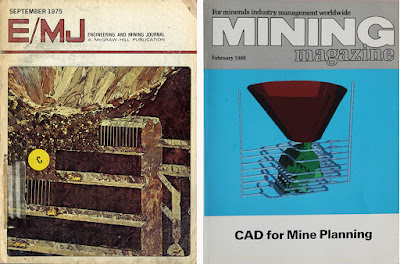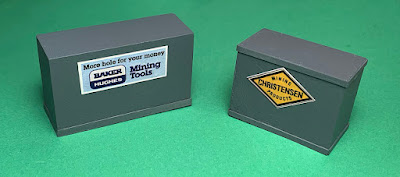Not long ago I received an interesting question at an operating session on someone else’s layout. One of the visitors came up to me and asked, with a smile, “You’re a freight car guy, right?” As long-time readers of this blog will know, that is indeed something I’ve been called before. (You can read some background at this link: https://modelingthesp.blogspot.com/2019/10/whats-freight-car-guy.html .)
When I acknowledged that I was such a guy, he posed his question: “How did brakemen operate those vertical-staff handbrakes with the wheels close to the roof?” What he meant, I believe, is shown below on a model of one of Southern Pacific’s temporary cabooses, converted from a box car, shown on the caboose track in my layout town of Shumala.
I began my answer by going back to the early history, when such brake staffs were a lot longer, intended for men working on the roof itself. As an example, below is an Ensign company photo (Cyril Durrenberger collection) of T&NO 1192, a car built in 1888, showing its B end. The grab iron row in this case is at the left edge of the end (about as many cars had them on the right edge), and clearly there is no brake step. A brakeman might have to operate this from the roof.
(The photo above, and the car photos below, can be found in my book “Box Cars,” Volume 4 in the series, Southern Pacific Freight Cars, Signature Press, 2nd edition, 2014). Below is a famous illustration from the 19th century, dramatically showing men applying handbrakes in a snowstorm.
As the illustration shows, at that time, before air brakes, brakemen had to move along the roofs of cars, setting the brakes by hand. This was perilous and obviously could and did lead to injury or death. I should emphasize, however, that at least as early as 1869, some cars did have brake steps, as shown in the Promontory, Utah view below (detail of A.J. Russell photo, Oakland Museum). It was up to the car buyer to make this choice in those days. Note that the brake staff and the grab irons are on the right.
By the end of the 19th century, it became common (and later was
required) to provide a step on the car end, for a brakeman to use when
setting hand brakes. The brake location on the left of the car center line also became standard. But as you see in the 1902 photo below (Steve Peery collection), the grab iron row might not be there at all, and brakemen had to use the grab irons on the car side.
It wasn’t until the Third Safety Appliance Act of 1910 that mandatory locations of safety appliances came into being (previous Acts were in 1893 and 1903). The photo below is on the hump at SP’s Taylor Yard in Los Angeles (SP photo). This clearly shows how a brakeman operated the hand brake with the wheel close to the roof surface.
This arrangement continued on house cars as long as there were vertical-staff hand brakes. But starting in the late 1920s, geared hand brakes became more and more common. This provided a considerable mechanical advantage for the brakeman applying the hand brake. The brake wheel was then attached to a gearbox, and thus had a horizontal instead of a vertical shaft. It was operated from not too different a position than shown in the photo above; this image is from a Cyclopedia advertisement.
One message from these photos is that the brake step was a very important part of a freight car for brakemen. After 1966, it was moved much lower on the car side, thereby avoiding the obvious risk of having to work at the car’s top. But the method of operation remained quite similar.
So those vertical-staff hand brakes, for any time substantially into the 20th century, should not be too tall, and of course should have a brake step. Brakemen certainly counted on the brake step when they had to apply hand brakes with that equipment.
Tony Thompson



















































